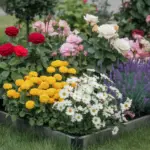6. Raised Bed Flower Garden: A Game-Changer for Small Spaces

Let me tell you something – my journey with raised bed gardening started about 15 years ago, and it completely transformed how I approach flower gardening. I still remember struggling with poor soil in my backyard until I discovered this amazing solution!
Building Your First Raised Bed
Creating your first raised bed might seem daunting, but trust me, it’s totally worth it! I learned the hard way that the foundation is everything. For flowers, you’ll want beds that are at least 12 inches deep to accommodate root systems. My personal sweet spot is using cedar boards that are 6 inches wide, stacked two high.
The ideal width? Keep it around 4 feet wide – this was a game-changer for me because it means you can reach the center from either side without stepping into the bed. Never compress the soil by walking on it – that’s a rookie mistake I made early on!
The Perfect Soil Mix
Here’s where the magic happens! After years of experimenting, I’ve found the perfect soil recipe: one-third topsoil, one-third compost, and one-third vermiculite. This combination provides excellent drainage while retaining enough moisture for your flowers to thrive.
Don’t skimp on soil quality – it’s literally the foundation of your garden’s success. I learned this lesson the expensive way when I tried to save money using regular garden soil. My dahlias and zinnias just sat there, barely growing until I upgraded the soil mix.
Smart Flower Spacing
Let’s talk about something that took me years to master – proper spacing! For most flowering plants, follow this simple rule: space them slightly closer in raised beds than recommended for in-ground gardens. The improved soil conditions support slightly denser planting.
Here’s my tried-and-true spacing guide:
- Tall flowers (like delphiniums): 12 inches apart
- Medium height flowers (like coneflowers): 8-10 inches apart
- Border flowers (like alyssum): 6 inches apart
Edge Planting Strategies
One of my favorite tricks is creating what I call “living borders.” Plant cascading flowers like sweet alyssum or trailing lobelia along the edges. They’ll spill over beautifully, softening the hard lines of your raised bed. This technique not only looks gorgeous but also maximizes your growing space!
Companion Planting Magic
Here’s something fascinating I’ve discovered: certain flowers just love growing together! I always plant marigolds throughout my beds because they naturally deter pests. Pairing tall and short flowers creates natural support systems – my cosmos provide perfect support for shorter snapdragons.
Want to know my absolute favorite combination? Zinnias, salvias, and verbena bonariensis. They create this amazing three-tiered effect that blooms all summer long!
Ready to discover another exciting way to maximize your small garden space? Up next, we’ll explore how to create a stunning Urban Flower Meadow that looks like it came straight out of a fairy tale! Click the next button below to learn how to transform your backyard into a magical wildflower haven that requires surprisingly little maintenance.
Remember, raised bed gardening is all about working smarter, not harder. With these techniques, you’ll be amazed at how much beauty you can pack into a small space. The key is starting with good bones – and that’s exactly what raised beds provide!









GIPHY App Key not set. Please check settings